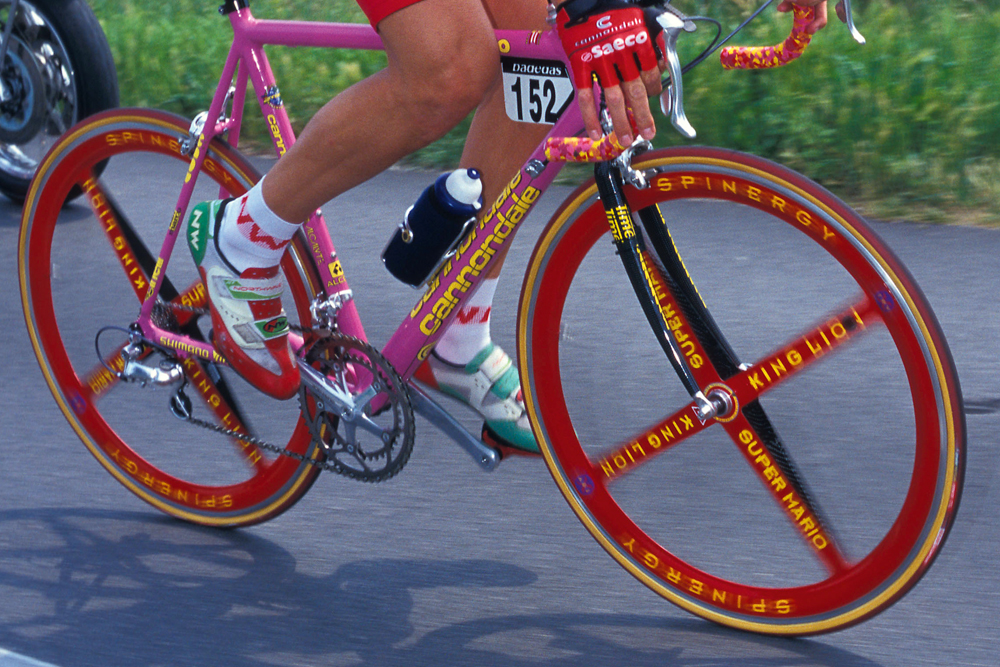Icons of cycling: Spinergy Rev-X wheels
Cutting-edge, four-spoked American fliers for riders who like to live on the edge

Photo: Yuzuru Sunada

Cool is never safe, which is why the pioneering Spinergy Rev-X with its dangerous look and even more dangerous reputation is the James Dean of wheels.
Fortunately, none of the crashes attributed to catastrophic failure of the four-spoke carbon-fibre design has been as serious as Dean’s, but a Google search on the Rev-X very quickly turns into a horror story involving Michele Bartoli’s kneecap being severed during the 1999 Tour of Germany, Paolo Bettini nearly cutting his hand off, and amateurs throughout the 1990s reportedly having Spinergy Rev-X wheels ‘explode’ underneath them without warning, causing broken bones and other gruesome injuries.
>>> Icons of cycling: Giant TCR
To spice up the Spinergy story further, there’s a conspiracy theory. When the UCI introduced its new wheel rules and regulations in 2001 it was claimed that the governing body had been persuaded by a Continental wheel manufacturer to introduce a particular type of rupture test solely with the intention of outlawing the American Spinergy Rev-X wheels.
Of course it can never be proven, but a former Spinergy engineer remained convinced the UCI had another agenda even after he’d left the company.
Need some new wheels?
Spinergy was set up by Rafe Schlanger, a former engineer at Cannondale. When Schlanger patented his radical design in the early 1990s nothing like the Rev-X had ever been seen. DuPont had already created what would become the Specialized tri-spoke, but that was completely different from Schlanger’s wheel.
The latest race content, interviews, features, reviews and expert buying guides, direct to your inbox!
The Rev-X looked like a monocoque from a distance, but its construction consisted of eight flat carbon spokes bonded under tension. It made a helicopter-like thwacking noise and it lent a bike a startlingly futuristic appearance.
Looking sharp

Schlanger made full use of his Cannondale connections and the Saeco team, led by talismanic sprinter Mario Cipollini, were early Rev-X adopters.
>>> Mario Cipollini’s response to criticism for not wearing a helmet is slightly x-rated
It wasn’t long, though, before the UCI expressed concern to Spinergy about spoke-edge sharpness — despite the edges of the Rev-X clearly not being as sharp as those of conventional bladed wire spokes. In 1998 the UCI was worried that the stiffness of composite wheels could cause vibration-related injuries to riders’ spines and wrists.
>>> Icons of cycling: Campagnolo Shamal wheels
Finally the UCI devised an impact test that the Rev-X could not pass. From that point on every wheel that had fewer than 16 spokes or a rim deeper than 2.5cm had to pass the rupture test.
So Spinergy stopped making the Rev-X, but for a wheel that supposedly could explode at any moment, there are still a lot of them still around 15 years on. Spinergy’s forbidden wheel has become the last word in retro cool.
Simon Smythe is a hugely experienced cycling tech writer, who has been writing for Cycling Weekly since 2003. Until recently he was our senior tech writer. In his cycling career Simon has mostly focused on time trialling with a national medal, a few open wins and his club's 30-mile record in his palmares. These days he spends most of his time testing road bikes, or on a tandem doing the school run with his younger son.
